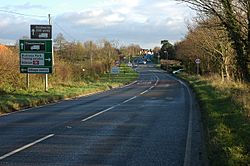William Neville (poet) facts for kids
Quick facts for kids
William Neville
|
|
|---|---|

Modern Pinvin, Worcestershire, where William Neville once resided
|
|
| Born | 15 July 1497 |
| Died | c. 1545 (aged 47–48) |
| Noble family | House of Neville |
| Spouse(s) | Elizabeth Greville |
| Issue |
|
| Father | Richard Neville, 2nd Baron Latimer |
| Mother | Anne Stafford |
William Neville was an English nobleman born on July 15, 1497. He lived in places like Penwyn and Wyke Sapie in Worcestershire. William was the son of Richard Neville, 2nd Baron Latimer. He is known for writing a book called The Castell of Pleasure. During his life, he faced some serious accusations, including claims that he was involved in magic. He passed away around 1545.
Contents
Who Was William Neville's Family?
William Neville was born into a large and important family. His father was Richard Neville, 2nd Baron Latimer, and his mother was Anne Stafford. Anne was the daughter of Sir Humphrey Stafford and Katherine Fray.
William had five brothers and six sisters:
- John Neville, 3rd Baron Latimer: His elder brother. John married three times. His third wife was Catherine Parr, who later became the sixth Queen of King Henry VIII.
- Sir Thomas Neville: He lived in Ardleigh, Essex. He married Mary Teye and had a son named Thomas.
- Marmaduke Neville: He lived in Marks Tey. He married Elizabeth Teye and had a daughter named Alianore.
- George Neville: He became an important church official, the Archdeacon of Carlisle.
- Christopher Neville: Another one of William's brothers.
- Margaret Neville: The oldest daughter. She married Edward Willoughby and had three daughters. One of her granddaughters, Elizabeth, was the grandmother of a famous writer named Fulke Greville, 1st Baron Brooke.
- Dorothy Neville: She married Sir John Dawney.
- Elizabeth Neville: She married Sir Christopher Danby. They had many children, including six sons and eight daughters. One of their daughters, Anne, was the grandmother of Walter Calverley, whose sad story was even written about in a play.
- Katherine Neville: One of William's sisters.
- Susan Neville: She married Richard Norton.
- Joan Neville: Another one of William's sisters.
After William's mother, Anne Stafford, passed away, his father married Margaret, who was the widow of Sir James Strangways.
What Did William Neville Do?
William Neville was involved in public life. From 1524 onwards, he sometimes served as a commissioner of the peace for Worcestershire. This meant he helped keep law and order in the area. He owned land in Worcestershire and Gloucestershire, some of which he received from his wife's father, Sir Giles Greville.
In 1532, William Neville faced serious accusations. Someone named Thomas Wood claimed that William had said the King would die. There were also claims that William was involved in magic. For example, it was said he tried to make a special "cloak of invisibility" using unusual ingredients like horse bones and powdered glass! His former chaplain, Edward Legh, also made similar claims. Luckily for William and his brothers George and Christopher, who were also investigated, they seemed to get through these charges without too much trouble.
In 1534, William Neville asked Thomas Cromwell, a powerful figure at the time, for help. William explained that he had lost a lot of money and was too poor to go to court to fix some problems he had.
William Neville's Book: The Castell of Pleasure
William Neville was also a writer. He wrote a book called The Castell of Pleasure. This book is an allegorical poem, which means it uses symbols and characters to represent ideas. In the poem, a character named Desire dreams he is led by Morpheus (the god of dreams) to a castle. There, he meets characters like Beauty. When he wakes up, the dreamer thinks about how much things change in life.
Other writers, like Robert Copland, added verses to William's poem. It is thought that The Castell of Pleasure was influenced by the poems of Stephen Hawes. The book was first published in 1518 by Henry Pepwell and then again around 1530 by Wynkyn de Worde.
The exact date William Neville died is not known. By 1545, his lands were being managed by his son, Richard.
William Neville's Marriage and Children
William Neville married Elizabeth Greville before April 1, 1529. Elizabeth was the daughter of Sir Giles Greville. She had been married before to Richard Wye.
William and Elizabeth had one son and two daughters:
- Richard Neville: He lived in Penwyn (which is now Pinvin) and Wyke Sapie in Worcestershire. Richard married Barbara Arden. They had a son named Edmund Neville.
- Mary Neville: One of their daughters.
- Susan Neville: Another one of their daughters.
After William's older brother, John Neville, 4th Baron Latimer, died without any sons, William's son, Richard Neville, incorrectly claimed the title of Baron Latimer. Richard's son, Edmund Neville, also tried to use this title after his father's death.

